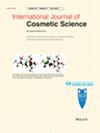Evaluation of the antioxidant and antityrosinase activities of Prosopis juliflora fruit extract as a novel multifunctional bioactive ingredient and its potential applicability in pro-ageing and skin colour harmonization cosmetic products
Abstract
Objective
Prosopis juliflora, commonly known as algaroba or mesquite, was introduced and has since proliferated throughout the semi-arid region of the Caatinga biome. Various studies have documented its properties, including antimicrobial, antioxidant, and antitumor activities, attributed to the presence of diverse secondary metabolites such as alkaloids, terpenoids, tannins, and flavonoids. The objective of this study was to evaluate the antioxidant and antityrosinase activities of P. juliflora fruit extract as a multifunctional active ingredient, and to develop cosmetic formulations containing this vegetal extract for potential applications in skincare products targeting pro-ageing and skin colour homogenization properties.
Methods
The extraction process followed established protocols. Chemical characterization of the extract involved quantification of total flavonoids and phenolic compounds, along with Liquid Chromatography-Mass Spectrometry (LC–MS) analysis. In vitro antioxidant activity was assessed using different methods. Antityrosinase activity was determined by employing enzymatic assays. Cosmetic formulations containing Disodium EDTA, Phenoxyethanol (and) Ethylhexyl Glycerin, Distilled Water, Sodium Acrylates Copolymer Lecithin, Polyacrylamide (and) C13–14 Isoparaffin (and) Laureth-7, and 3.0% of the investigated plant extract were subjected to preliminary and accelerated stability tests.
Results
The extract demonstrated a concentration of total flavonoids (1.71 ± 0.26 μg EQ/mg) and exhibited concentrations of phenolic compounds at 0.21 ± 0.01 mg EAG/g. Metabolites such as flavonoids and saponins were annotated, as well as some of their respective glycosidic derivatives. The extract showed antioxidant potential and the ability to inhibit the oxidation cascade in both the initiation and propagation phases. Moreover, the extract exhibited noteworthy inhibition of antityrosinase activity, presenting 62.48 ± 2.09 at a concentration of 30.00 mg/mL. The formulations were stable in accelerated stability tests over a 60-day period.
Conclusion
This research not only demonstrates scientifically by demonstrating the potential of a plant from the Caatinga biome with antioxidant and antityrosinase properties in the development of cosmetic products aimed at pro-ageing effects and skin colour harmonization, but also adds value to the P. juliflora production chain. This valorization encompasses various aspects which include environmental, social, and biodiversity responsibilities.


 求助内容:
求助内容: 应助结果提醒方式:
应助结果提醒方式:


